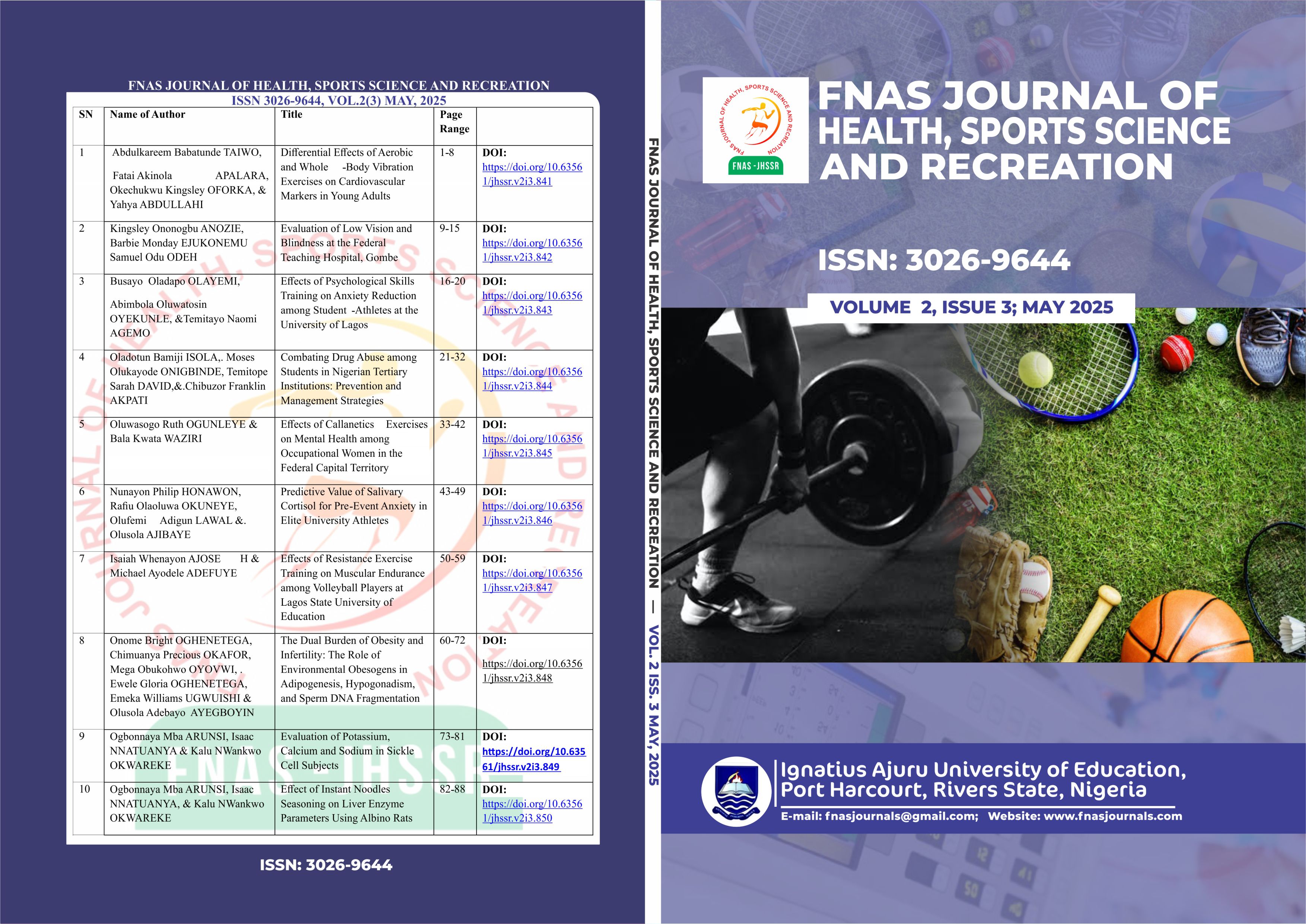Evaluation of Low Vision and Blindness at the Federal Teaching Hospital, Gombe
DOI:
https://doi.org/10.63561/jhssr.v2i3.842Keywords:
Blindness, Low Vision, Eyes, Gombe, Federal Teaching HospitalAbstract
Low vision and blindness are significant global health concerns that affect millions of individuals, impacting their ability to perform daily activities and participate fully in society. Low vision refers to a visual impairment not fully correctable by standard glasses, contact lenses, medication, or surgery, and that interferes with normal functioning. Blindness typically involves a more severe level of vision loss, ranging from profound impairment to complete loss of sight. The causes of low vision and blindness are diverse and include age-related conditions such as macular degeneration and glaucoma, congenital or hereditary disorders, injuries, and systemic diseases like diabetes. This study aimed to evaluate the prevalence and causes of low vision and blindness at Federal Teaching Hospital Gombe (FTHG), Northeastern Nigeria. A total of 7040 participants who gave their informed consent were recruited and evaluated at the Optometry Unit. Results showed that the prevalence of low vision and blindness was 9.46% and 0.07%, respectively. Glaucoma (28.5%), refractive errors (23.2%), and maculopathy (14.9%) were the leading causes of low vision. Glaucoma was the sole cause of blindness. Age was significantly associated with low vision (P<0.05), but gender was not. Myopia was the most common refractive error (39.1%). This study highlights the need for early and improved eye care services and awareness in the region.
References
Akano, O. F. (2014). Vision Health Disparity and Reasons for no Access to Vision Care Among United States Adults Aged 40 and Above-BRFSS, 2007-5 States. Int J Res Dev Health. September 2(3), 99-106.
Akano, O. F. (2017). Vision health disparities in blindness and visual impairment in Nigeria: A review of the Nigerian National Blindness and Visual Impairment Survey. African Vision and Eye Health, 76(1), 1-5. DOI: https://doi.org/10.4102/aveh.v76i1.345
Avitia, D., Baldwin, J., McFadden, I., Rowland, B., Rodriguez, P., & Pennington, C. G. (2024). Blindness and Visual Impairment. Make it Count,
Barbie, O. M. E. (2004). Characteristics of Nigerian low vision population. Journal of the Nigerian Optometric Association, 11. DOI: https://doi.org/10.4314/jnoa.v11i1.64437
Bosanquet, N., & Pritti, M. (2005). Evidence base to support the UK vision strategy. UK Vision Strategy, 123(8), 10–15.
Bourne, R. R. A., Flaxman, S. R., Braithwaite, T., Cicinelli, M. V., Das, A., Jonas, J. B., et al. (2017). Magnitude, temporal trends, and projections of the global prevalence of blindness and distance and near vision impairment: A systematic review and meta-analysis. The Lancet Global Health, 5(9), e888–e897. https://doi.org/10.1016/S2214-109X(17)30293-0
Bourne, R. R. A., Flaxman, S. R., Braithwaite, T., Cicinelli, M. V., Das, A., Jonas, J. B., et al. (2017). Magnitude, temporal trends, and projections of the global prevalence of blindness and visual impairment: A systematic review and meta-analysis. The Lancet Global Health, 5(9), e888–e897. DOI: https://doi.org/10.1016/S2214-109X(17)30293-0
Fasina, F. O., & Ajaiyeoba, A. I. (2003). The prevalence and causes of blindness and low vision in Ogun State, Nigeria. African Journal of Biomedical Research, 6, 63–67. DOI: https://doi.org/10.4314/ajbr.v6i2.54026
Holden, B. A., Jong, M., Davis, S., Wilson, D., Jong, E., Naidoo, K., et al. (2015). Nearly 1 billion people worldwide have distance vision impairment. British Journal of Ophthalmology, 99(9), 1295–1297. https://doi.org/10.1136/bjophthalmol-2015-307754
Köberlein, J., Beifus, K., Schaffert, C., & Finger, R. P. (2013). The economic burden of visual impairment and blindness: A systematic review. BMJ Open Ophthalmology, 3(11), e003471. DOI: https://doi.org/10.1136/bmjopen-2013-003471
Limburg, H., & Keunen, J. E. E. (2009). Blindness and low vision in The Netherlands from 2000 to 2020: Modeling as a tool for focused intervention. Ophthalmic Epidemiology, 16(5), 362–369. DOI: https://doi.org/10.3109/09286580903312251
Massof, R. W. (2002). A model for the prevalence and incidence of low vision and blindness among adults in the US. Optometry and Vision Science, 79(1), 31–38. DOI: https://doi.org/10.1097/00006324-200201000-00010
Mpyet, C., & Solomon, A. W. (2005). Prevalence of low vision and blindness amongst persons living in leprosy villages in northeastern Nigeria. British Journal of Ophthalmology, 89, 417–419. DOI: https://doi.org/10.1136/bjo.2004.048777
Oluyadi, F. O. (2003). In Fasina, F. O. & Ajaiyeoba, A. I. The prevalence and causes of blindness and low vision in Ogun State, Nigeria. African Journal of Biomedical Research, 6(2), 63–67.
Pizzarello, L., Aiose, A., Ffytche, T., Duerksen, R., Thulasiraj, R. D., Taylor, H., Faal, H., Rao, G., Kocur, I., & Resnikoff, S. (2004). VISION 2020: The right to sight—A global initiative to eliminate avoidable blindness. Archives of Ophthalmology, 122, 615–620. https://doi.org/10.1001/archopht.122.4.615 DOI: https://doi.org/10.1001/archopht.122.4.615
Resnikoff, S., Pascolini, D., Etya’ale, D., Kocur, I., Pararajasegaram, R., et al. (2006). Global data on visual impairment in the year 2002. PLoS Medicine, 3(12), e477. https://doi.org/10.1371/journal.pmed.0030477 DOI: https://doi.org/10.1371/journal.pmed.0030477
Taylor, H. R., Keeffe, J. E., Vu, H. T., Wang, J. J., Rochtchina, E., Pezzullo, M. L., & Mitchell, P. (2005). Vision loss in Australia. Medical Journal of Australia, 182(11), 565–568. DOI: https://doi.org/10.5694/j.1326-5377.2005.tb06815.x
World Health Organization. (2013, February 10). Visual impairment and blindness: Key facts. http://www.who.int/mediacentre/factsheets/fs282/en/


